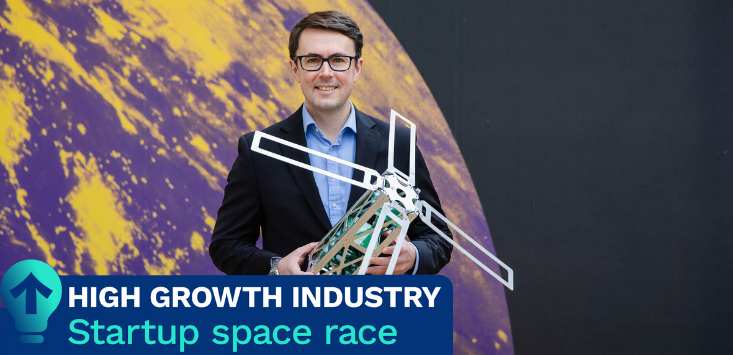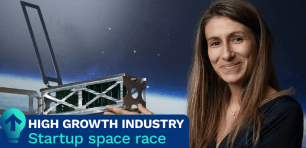
Myriota co-founder Alex Grant. Source: supplied.
As the cost of launching objects into space comes down and the availability of private space launches increases, getting a satellite into space can cost half a million dollars instead of millions.
It’s also a function of size and weight. From satellites measured in tonnes, the sector has moved to kilograms. These small satellites are called ‘cubesats’, because they are built in 10cm x 10cm modules.
Cubesats have completely reshaped the economics and viability of space-enabled businesses. Space used to exclusively be the domain of governments, and the defence contractors that worked alongside them.
Now startups like Myriota, which offers satellite-linked remote communications for internet-of-things (IoT) devices, can flourish.
Its backers think the same, including CIA-adjacent venture capital fund In-Q-Tel, former Prime Minister Malcolm Turnbull, Singtel Innov8 and Boeing Horizon X, along with its lead investors Host Plus and CSIRO’s Main Sequence Ventures.
Myriota doesn’t publicly share its revenue figures, but it has attracted $50 million in outside investment since launching in 2015, when it was formed to commercialise a communication technology breakthrough made at the University of South Australia by co-founders Alex Grant and David Haley.
It’s a great time to be in the space game, as the attention of the world is drawn to Jeff Bezos, Elon Musk, and Richard Branson’s personal space race.
“We’re living in the future where eccentric billionaires launch themselves and sports cars into space. When I walk down the street, and see three different people wearing NASA or SpaceX t-shirts, you can see space is in the air,” says Grant.
Myriota now has a presence in Canada, is offering services across North America, and is building out its American team, following its foothold in Australia and New Zealand.
Myriota’s network of seven nanosatellites orbit some 500-600km from the surface of the Earth, having hitched lifts with Elon Musk’s SpaceX and Rocket Lab, and creatively retrofitted its software to existing satellites.
By the end of 2022, it aims to more than triple that number to 25.
While that might not seem like many individual satellites, each can push through hundreds of millions of IoT messages at any moment. A single loaf-of-bread sized device could handle every connected device in the United States.
“We expect that to be millions, or even billions of devices eventually,” Grant tells me without a hint of exaggeration.
That scalability is what sets the company apart, and is why the company was founded after the researchers invented the technology.
Everyone has been on a busy WiFi network — it’s frustrating to say the least — and what Myriota offers eliminates congestion as an issue.
Five key takeaways
If you’re building a tech product, you should consider scalability first.
Your early investors can be much more valuable than the money they bring.
Opportunity brings talent. If you’re not getting applicants, consider rewriting your job posting to highlight the long-term future of the role, and the company.
If you’re selling high-tech products, don’t confuse your customers with jargon. Bring the focus entirely on what the technology does for their business, in a real and practical sense.
If you’re considering moving into an innovation district, it’s worthwhile if you will be located next to other companies that bring opportunity for your own.
Smart partnerships, and a shortcut to space
Instead of launching its own satellites, which would have cost hundreds of thousands of dollars, Myriota first took a shortcut to space.
In its seed funding round, a Canadian maritime company called exactEarth provided $2 million in capital to Myriota.
As exactEarth already had its own satellites in space, Myriota reconfigured one to send messages on its own network.
Instantly, exactEarth went from one of its first investors to its first customer.
Myriota went on to acquire most of exactEarth’s satellites, and the team that operated them, paying CA$150,000 ($163,000) in cash, and CA$450,000 in shares.
It was a textbook definition of win-win, with exactEarth saving CA$1 million a year in running costs, and Myriota saving the cost of four satellite launches.
“It’s been a productive and positive partnership from the start,” says Grant.
In fact, Myriota had also used exactEarth’s satellites when testing the technology at the University of South Australia.
Similarly, Myriota has leaned on backers Singtel Innov8 and Boeing Horizon X, using the knowledge of the global telco and aerospace business. But how does it formalise these partnerships and get the most out of them?
For Grant, it was key to discuss the value of what each investor could bring before accepting the investment.
“What comes alongside the money? What’s the cultural and commercial fit? It’s important that you are aligned, and there is a common purpose or compatibility with different shareholders,” says Grant.
When Myriota hasn’t seen that alignment, it has declined. For Grant, accepting the wrong kind of money is even worse.
“It’s easy to overlook it and say, ‘it will be alright’ but if it isn’t there, it won’t be right. Where the fit is right, the value you get will exceed the value of investment,” says Grant.
“If investing cash was all there was to making successful companies, there would be no need for strategy, or management, or boards. You would put money in and magic would happen. But that’s not how investing works.”
Opportunity brings talent
While hiring is a broad issue with most companies seeking out the best talent in the market, Grant says he’s never had an issue finding the right people.
“I don’t think it is hard to get good people. It’s hard to create opportunities. Good opportunities attract good people. When people talk about talent gaps, they are talking about opportunity gaps,” he tells me.
What has helped Myriota most is leveraging what the company is doing, and its goals, to attract talented and diverse staff.
“When you’re growing, you need to be careful that you do not rush in getting the right person, not just in the technical aspects: that could be anything from coding to accounting,” says Grant.
“You also need the alignment or purpose and cultural fit. Those things can make life hard and hold you back. Ability and hard work needs to be there as well.”
When listing jobs, Grant always highlights the broader experience around the company, and not just the mechanical aspects of what’s involved in the job.
For each role, Myriota attracts a lot of applicants. Grant says you need to set apart enough time to get through each application, working through them steadily. That’s time well spent.
“People talk about companies like abstract notions, but a company is really the people inside it: how they interact, what they do, and how they work together,” says Grant.
Maximising the benefits of an innovation district
Myriota is based in South Australia’s Lot Fourteen innovation district. It’s a focus point for the state, which Grant says helps, along with being next to other like-minded companies.
As an example, it is now working with fellow-space company Inovor to build a satellite that will provide services for the South Australian government.
“That is the what gets catalysed through that co-location proximity, when you have like-minded people that can work together,” says Grant.
Lot Fourteen also hosts the headquarters of the Australian Space Agency, conveniently in the same building as Myriota.
As a result, Myriota gets a lot of flow-through of visitors. A casual call might come through from the space agency mentioning that NASA guests had arrived, and they’d like to pop in for a visit.
“Opportunity comes literally knocking at your door,” says Grant.
So for businesses considering whether or not to be a part of an innovation district, the real question is what opportunities will being located there bring to your business organically, just through proximity.
Selling space
What Myriota does is extremely technical, and involves communication protocols between devices, leveraging nanosatellites, micro transmitters, and a bunch of other technologies that have no meaning outside of the experts that create and use them.

Vishak Palanivelu working in the Myriota innovation lab. Source: supplied
I asked Grant how he brings that technology back to Earth when they’re selling their products.
“The trick is to not talk about any of that,” he tells me, laughing.
What customers want to know is how the technology can improve the logistics for the delivery of fuel, or how they can better understand their environment with the technology.
So you explain what the technology does: it allows the customer to collect data from sensors in remote areas that do not have an internet connection, bouncing the data into a satellite, which then uploads it to the cloud, which the customer can have oversight on.
“While we absolutely leverage infrastructure in space, and people like to think of Myriota as a space company, we’re actually a ‘getting-data-to-do-good-work’ company that uses space, electronics, algorithms, and software to make that happen,” says Grant.
He has a point. Google Earth relies on satellites, but it’s not thought of as a space technology. He believes the space elements of space-enabled tech will likely become invisible in the same way.
Positivity and enthusiasm for space
When Myriota set out to raise funds in 2016, Grant was told by other people in the industry that aiming for the millions of dollars that the company needed was a waste of time and effort.
“I had no shortage of people telling me it was impossible, or that I should try to raise $20,000 and somehow do the same stuff,” he says.
“Australia can fall into a trap of saying ‘no we can’t do it’. I think we’re at a really interesting point of time where people are doing it.
“The general environment for startups and opportunity today, compared to 2015 when we started Myriota, or the early 2000s, it’s just not comparable. It’s an incredibly exciting time. It’s fantastic to see companies growing and succeeding, and Australia more broadly finding its feet.”
Grant compares the hype and enthusiasm now to Myriota’s frugal start in 2015, and one memory sticks: bolting together $16 chairs from IKEA to set up the company boardroom in the basement of a tiny office.
“They served us very well.”
Handpicked for you

Community is key in Aussie space tech success, says Fleet’s Flavia Tata Nardini



COMMENTS
SmartCompany is committed to hosting lively discussions. Help us keep the conversation useful, interesting and welcoming. We aim to publish comments quickly in the interest of promoting robust conversation, but we’re a small team and we deploy filters to protect against legal risk. Occasionally your comment may be held up while it is being reviewed, but we’re working as fast as we can to keep the conversation rolling.
The SmartCompany comment section is members-only content. Please subscribe to leave a comment.
The SmartCompany comment section is members-only content. Please login to leave a comment.